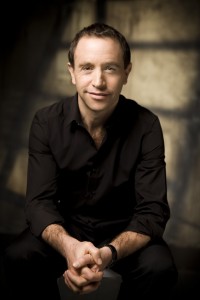UTAH SYMPHONY, Abravanel Hall, May 23; second performance 8 p.m. May 24, tickets at 801-355-2787, 888-451-2787 or www.utahsymphony.org
[DISCLAIMER: I’ve known cellist Matthew Zalkind, this weekend’s guest artist, since he was an infant. So if you choose not to believe all the glowing things I’m about to say regarding his performance Friday of Tchaikovsky’s Variations on a Rococo Theme, that’s your prerogative. But you’d be wrong.]
The charm and elegant simplicity of the Rococo Variations exhibit Tchaikovsky’s deep affinity for Mozart. Zalkind not only understood this, but had enough confidence not to try to over-impress with the hyper-romanticized schmaltz typical of so many cellists who perform this piece. Especially for someone just embarking upon a career, the result was that much more impressive. With facile technical command and unfailing good taste it would not surprise me at all if that career vaults him into the top echelon of concert artists.
The program began with Carl Nielsen’s Sixth Symphony. Nielsen’s music is an acquired taste. That doesn’t suggest it isn’t worth acquiring, because other things Danish, like aquavit and smoked fish, can grow on you over time and the world would undoubtedly be the lesser without them. Nevertheless, Nielsen hasn’t been embraced by American audiences as much as others of his era who also had strong national tendencies, such as Bártok from Hungary or Sibelius from Finland. I’m not sure why that is the case. Nielsen’s finely crafted symphony certainly has a distinctively fresh voice and conveys a wide range of expression, from burlesque-like humor to prayerful reverence. On the other hand, occasionally there’s the sense that sometimes things do seem to happen randomly and wander aimlessly, at least to my ear. To a Dane’s ear, though, Nielsen may well sound as comfortably familiar as Aaron Copland does for us, so Maestro Thierry Fischer and the Utah Symphony, by having performed all of his symphonies this season, should be thanked for providing us with that opportunity to make Nielsen more accessible.
Rachmaninoff’s propensity for lush overstatement is perhaps the most endearing quality of his music. The Symphonic Dances evokes images of a turgid Bette Davis/Ray Milland noir drama, and I suppose there’s nothing wrong with that. I have a lot of respect for Rachmaninoff’s skills and melodic gift, but maybe because only recently I was involved in oft-repeated performances of his Rhapsody on a Theme of Paganini, by the time Friday’s Symphonic Dances ended I felt as if I had grossly overindulged at the Stein Ericksen Sunday buffet.
That notwithstanding, it should be noted how wonderfully the musicians of the Utah Symphony sound these days! The Nielsen symphony, especially, is awfully difficult for all concerned, but from the symphony’s first notes on Keith Carrick’s glockenspiel to the violin section wailing through two nightmarish pages of sixteenth notes in the last movement, everyone’s playing was as good as one could wish for from any orchestra. The work that Maestro Fischer has done with the musicians is clearly paying off, and he seemed more confident and relaxed conducting them than on previous occasions, guiding the ensemble rather than controlling it. Plus, there are a bunch of very fine new and young players, so the future for the orchestra, musically anyway, looks very bright.
In recognition of it being the final weekend of this season’s Masterworks series, Maestro Fischer and the orchestra rewarded the audience with a dashing encore of the Nielsen Maskarade Overture as a token of thanks for its continued support.

